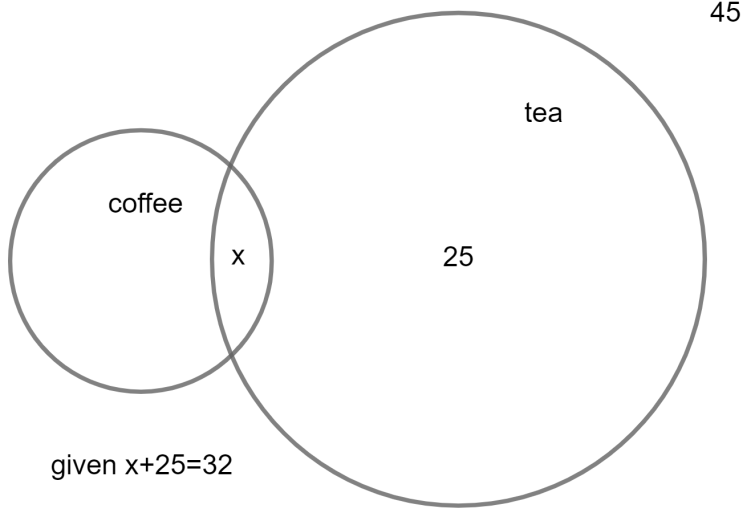
In a group of $45$ persons, $25$ drink tea but not coffee, while $32$ drink tea. How many people drink coffee but not tea?
(A) $12$
(B) $13$
(C) $15$
(D) $20$
Answer
135k+ views
Hint: For answering this question we will find the total number of persons who drink coffee but not tea from the given information that is the total number of people present is $45$ and the total number of people who drink tea is $32$. So if we subtract the total number of people who drink tea from the total number of people present we will have the total number of people who drink coffee but not tea.
Complete step-by-step solution:
Now considering the question we have the information stating the total number of persons present in the group is $45$ and the number of persons who drink tea but not coffee is $25$ and the total number of people who drink tea is $32$.
Let us assume the number of people who drink both coffee and tea at $x$.
Then we will have a Venn diagram representing this information as follows:

And now we can derive the number of people who drink both coffee and tea assumed as $x$ and tea by subtracting the number of people who drink tea but not the coffee that is given as $25$ from the total number of people who drink tea which is given as $32$ this can be given mathematically as
$\begin{align}
& x=32-25 \\
& \Rightarrow x=7 \\
\end{align}$ .
Since we have the total number of people present is $45$ and the total number of people who drink tea is $32$ so the number of people who drink coffee only will be $45-32=13$.
Therefore we can conclude that the total number of persons who drink coffee but not tea is $13$.
Hence option B is correct.
Note: While answering questions of this type we should take care of the calculations. If we had made a mistake during the calculations and taken the difference between the total number of people present that is $45$ and the total number of people who drink tea that is $32$ as $45-32=12$ which will imply us to mark option A as correct which is wrong.
Complete step-by-step solution:
Now considering the question we have the information stating the total number of persons present in the group is $45$ and the number of persons who drink tea but not coffee is $25$ and the total number of people who drink tea is $32$.
Let us assume the number of people who drink both coffee and tea at $x$.
Then we will have a Venn diagram representing this information as follows:

And now we can derive the number of people who drink both coffee and tea assumed as $x$ and tea by subtracting the number of people who drink tea but not the coffee that is given as $25$ from the total number of people who drink tea which is given as $32$ this can be given mathematically as
$\begin{align}
& x=32-25 \\
& \Rightarrow x=7 \\
\end{align}$ .
Since we have the total number of people present is $45$ and the total number of people who drink tea is $32$ so the number of people who drink coffee only will be $45-32=13$.
Therefore we can conclude that the total number of persons who drink coffee but not tea is $13$.
Hence option B is correct.
Note: While answering questions of this type we should take care of the calculations. If we had made a mistake during the calculations and taken the difference between the total number of people present that is $45$ and the total number of people who drink tea that is $32$ as $45-32=12$ which will imply us to mark option A as correct which is wrong.
Recently Updated Pages
JEE Main 2021 July 25 Shift 2 Question Paper with Answer Key

JEE Main 2021 July 25 Shift 1 Question Paper with Answer Key

JEE Main 2021 July 20 Shift 2 Question Paper with Answer Key

JEE Main 2021 July 22 Shift 2 Question Paper with Answer Key

How to find Oxidation Number - Important Concepts for JEE

Half-Life of Order Reactions - Important Concepts and Tips for JEE

Trending doubts
JEE Main 2025 Session 2: Application Form (Out), Exam Dates (Released), Eligibility, & More

An aeroplane left 50 minutes later than its schedu-class-11-maths-JEE_Main

JEE Main 2025: Derivation of Equation of Trajectory in Physics

Degree of Dissociation and Its Formula With Solved Example for JEE

Electric Field Due to Uniformly Charged Ring for JEE Main 2025 - Formula and Derivation

Elastic Collisions in One Dimension - JEE Important Topic

Other Pages
JEE Advanced Marks vs Ranks 2025: Understanding Category-wise Qualifying Marks and Previous Year Cut-offs

NCERT Solutions for Class 11 Maths Chapter 8 Sequences and Series

NCERT Solutions for Class 11 Maths Chapter 10 Conic Sections

NCERT Solutions for Class 11 Maths Chapter 9 Straight Lines

NCERT Solutions for Class 11 Maths Chapter 6 Permutations and Combinations

NCERT Solutions for Class 11 Maths Chapter 13 Statistics




